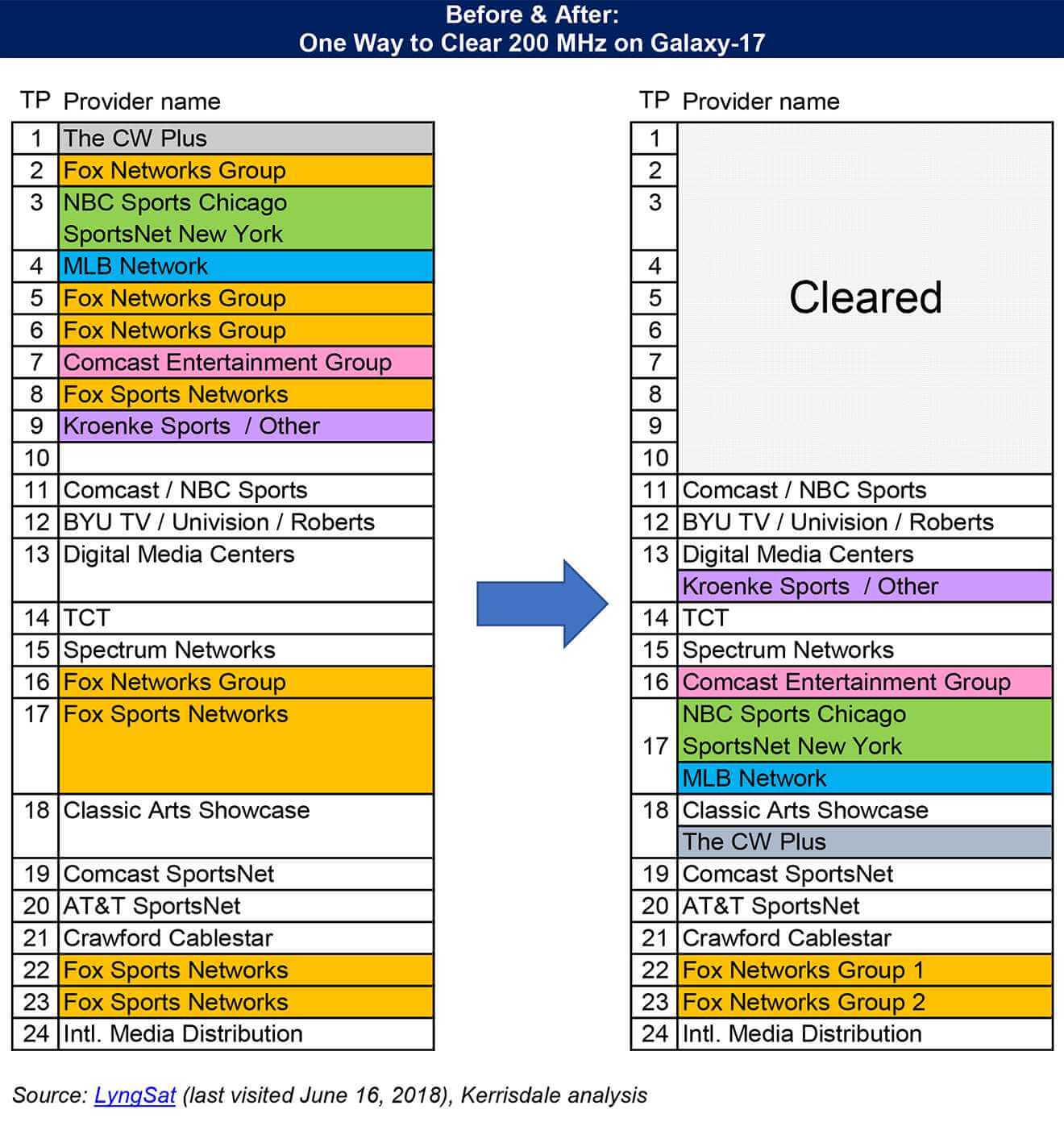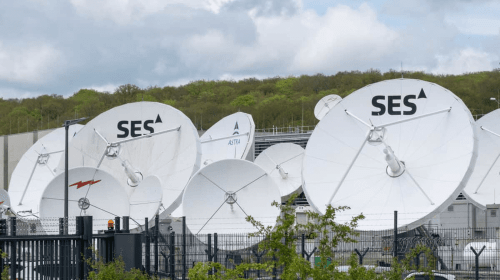Sep 12, 2018
Articles here have discussed some of the hubbub surrounding C band recently. In the US, the hubbub is approaching a crescendo, and things are heating up fast. Two satellite providers, Intelsat and SES own most of the C band capacity blanketing CONUS, and the 5G mobile industry wants it. They want it bad.
C Band Review
C band is a set of frequencies used by GEO (Geosynchronous Earth Orbit) satellites. These stationary satellites located above the equator utilize two sets of frequencies. 3.7 – 4.2 GHz is for transmission from space to earth, and 5.925 – 6.425 GHz is used for transmission from earth to space. The FCC is evaluating proposals to use the 3.7-4.2 GHz capacity for mobile use, in addition to legacy satellite use. This range is judged to be the “spectral sweet spot” for 5G technology known as massive MIMO. Owning this spectrum provides a huge competitive advantage.
Let the Market Decide
Today this C band capacity is mostly used for video distribution by creators of TV content such as Disney and Fox, and distributors of the content, such as Comcast and DirecTV. The normal course of things in such situations is to try and get the government, the FCC, to dictate how the capacity will be used, and to reallocate it – an ugly process. The key players in this drama have suggested that in this case, the market should decide. Under their plan, a consortium of C band providers will auction off a portion of the spectrum to mobile operators such as Verizon and AT&T.
The signals all point to support for this plan. It is in line with the current administration’s free market practices, and the FCC appears inclined to support the deal. 5G is a major prerogative for the government. The US must be competitive in implementing this new technology, and C band capacity appears to be essential to making that happen as quickly as possible. The only players of any importance are Intelsat and SES, (Eutelsat and Telesat have small portions of C band capacity over CONUS), and they understand the nuances of supporting their current businesses while, at the same time, leveraging an extremely valuable resource that potentially leads to huge profits.
C band is Important to 5G Deployment
The FCC is interested in C band because it has practical goals in mind, namely 5G. 5G is critical for defense and commercial purposes. The FCC wants US companies to help shape the growth, standards and capabilities of 5G, as this has significant impact on economic success in the future. Being dictated to by other regimes who may not be as capitalist as the US, is not an attractive option, so anything that promotes 5G is important. The US government wants to see 5G deployments begin soon and in significant numbers.
The Intelsat/SES proposal is primed for fast action, while other options are all likely to bog down. The history of reallocating spectrum by issuing regulations confirms the time and difficulty involved in this process. When the idea of reallocating this C band capacity first came up, opposition was strong and fierce. Over time, even the most vehement have begun to turn, and in some cases embrace the proposal. Additional proposals continue to be floated, but the pack seems to be settling on the Intelsat/SES proposal, as the least disruptive, least complex, and fastest to implement.
Why is C band so Valuable?
Industry leaders including Nokia, Verizon, T-Mobile, the GSM Association, Cambridge Broadband Networks and others have been effusive in their praise of C band as the ideal choice for nationwide 5G. The choice is particularly important for “widespread” deployment of 5G. Initially market participants expected high frequency millimeter-wave spectrum to be deployed for 5G, but this spectrum requires very dense and costly network buildouts. These higher frequencies are likely to be used for urban hot spots.
Lower frequency C band, when leveraging 5G technology called massive MIMO (multiple-input, multiple-output) resembles conventional cellular spectrum. hat means it can work, not just in densely populated small cells, but on traditional “macro” cell sites such as towers. 5G spectral efficiency allows large amounts of data traffic to be carried by this bandwidth. With hundreds of megahertz put to work, C band can enable huge improvements in network traffic, and not just in small-cell hot spots, but across the country. Given that other countries are also looking to repurpose C band for 5G, there will be a rich supply of product solutions including network equipment and user devices.
Within the 5G movement, the high frequency vs low frequency discussion has shifted thanks to “massive MIMO” a transformational technology. The data-trafficking capacity of a unit of spectrum can be multiplied several-fold by operators. By leveraging many antennas (64, or 128 for example), in a precisely coordinated fashion, massive MIMO not only enables higher throughput, but enhanced coverage. It’s like having many ears and many megaphones, each covering a concise area.
Very high-frequency solutions using mmWave (millimeter-wave) spectrum will require very dense deployments – a small cell on every corner. Massive MIMO combined with C band’s mid-range frequencies will provide huge increases in capacity – and will rely on the existing grid of towers. This spectrum will support higher user mobility than the mmWave spectrum that will be limited to small cells with low user mobility.
The Challenge
Until recently, frequencies as high as 4 GHz, which includes the C band spectrum in question, would not have provided strong signal propagation. Like mmWave spectrum they would have required high density, expensive deployment of small cells. MIMO however, by increasing antenna counts, compensates for the propagation deficit, and thus does not demand higher cell density. It’s also greatly improves speed and capacity.
The problem is that an array of many antennas can be too large to be safely or easily installed on current towers. The size of the antennas is related to the frequency. A low-frequency spectrum such as the 700 MHz band requires large antennas. C band with its relatively higher frequencies, now provides an advantage. By way of example, Huawei, an equipment vendor, has demonstrated that massive-MIMO antenna arrays operating just below C band spectrum at 3.5GHz can be 36% shorter and 43% narrower than similar arrays using 1.8GHz spectrum (both spectra commonly used overseas). Assuming the trend continues, C band at 3.7GHz should reduce hardware size and cost even further.
Additional spectrum is being considered to deploy 5G, such as Sprint’s 2.5GHz spectrum. Contrasting Sprint’s spectrum with C band, what the technical discussion boils down to is that C band spectrum can achieve similar coverage as conventional cellular bands, while coming in cheaper. It is also more practical when using 5G massive-MIMO hardware which is smaller and less expensive. This will be important to consider, when looking at financials, because it means that C band should reasonably be given a value that is at least equal to Sprint’s cellular spectrum.
How much Spectrum can be Cleared?
The Intelsat/SES proposal calls for C band spectrum to be cleared throughout the lower 48 states. The greater impact on C band from Alaska and Hawaii, make them unattractive for participation. The term MHz-pop is used to define the cost of the spectrum, where pop refers to the population that is to be covered by the spectrum. The lower 48 states have a population of about 307 million people. A couple areas must be excluded, such as Atlanta which has a high population of earth stations that are used to control and track the satellites themselves. Researchers round off to 300 million, the number that can potentially be covered with the C band spectrum.
The original proposal calls for 100 MHz of cleared frequency to be achieved within a year and a half to three years. Clearly the demand is such that there will be calls for more, and for Intelsat, SES and the rest of the consortium, if the price is right, there’s every reason to try and clear more. Will they be incented to clear more?
C band operations in the US currently generate $340 million in annual revenue according to the Satellite Industry Association. This translates to a market value based on current uses of C band, of about $2 billion. Comparing that with the full 500 MHz of available C band and using a conservative value of $.50/MHz-pop, along with a 300 million population figure, the entire band is worth $75 billion. Yes, there would be costs to clear out that capacity, but setting those aside, the upside is absolutely enticing. Why would the operators stop at 100 MHz? Clearly there will be an incentive on the part of the operators to clear as much spectrum as they can.
Intelsat and SES are consistent in their promises to protect their current customers and their businesses. They can’t walk away from Disney, Fox, and local TV broadcasters as the FCC would take a dim view of this. In exchange for a multi-billion-dollar windfall, they will need to provide a smooth transitional path. Nevertheless, it can’t help but be noted that they hold the cards. Worst case, they could simply let current contracts run out and expire and refuse to renew them. They could also hike the price for C band capacity. Some customers such as the pay-tv industry would likely bite the bullet, but other players such as Disney, Fox, etc. might find another way to distribute their content, and give up on C band. Observers expect that the market will drive the prices, and the amount of heavy-handedness will be minimal. Although they are highly unlikely to evict current customers, it should be remembered that they could do so.
Researchers have determined that of the 500 MHz that is available, 400 MHz could be freed up over a 5 to 10-year period, while continuing to support current conventional use.
How to Clear the Spectrum
The first challenge is understanding how the current commercial services are distributed. Of some 2000 video feeds delivered over 24 satellites, most have ended up on a small number of satellites. The reason for this, is because an owner of a second-tier channel is willing to pay a premium to be on the same satellite as a top-tier channel like HBO. In this way, a cable company or other distributor can use one antenna to receive content from multiple providers. As a result, what the industry ended up with is a handful of satellites that are heavily used, while most others are much less crowded. Existing incentives have the industry relying on more spectrum but fewer satellites. The Intelsat/SES proposal reverses this dynamic. Instead channels will spread out over a wider range of satellites, but with fewer active transponders, and thereby make room for terrestrial use of the spectrum.
Today there are no strong incentives to be frugal with spectrum usage, and many C band video feeds are particularly inefficient, wasting a lot of spectrum. Outdated compression algorithms and other technical standards continue to be used widely. The best existing technology, DVB-S2X leveraging a codec called HEVC, means a single transponder can handle about 20 HD (high definition) channels. If we take the 2000 active channels (most of which are not HD) and allocate them across transponders at 20 each, we end up with 100 transponders. Across all 24 US C band satellites, there are 576 transponders in total, so theoretically 87 MHz could handle everything, leaving 413 MHz for terrestrial use.
All these channels won’t switch to DVB-S2X overnight, and many customers won’t be happy about changing satellites. However, some savings seem like no-brainers. There is probably no need for 2000 channels, when the typical subscriber will typically have 200 channels. Most of the channels are redundant with standard and HD versions running simultaneously. Some programs may be run more than once, to accommodate for time zones. These issues are easy to solve. A cable company that wants to run an SD lower definition channel, can simply down-convert the HD. Content for the west coast can simply be stored and then run at the appropriate time, rather than transmit it twice. There is a lot of room to reduce the number of channels and free up capacity for terrestrial 5G. Clearing 400 MHz will not be fast or easy, but targeting 100 MHz to start seems eminently reasonable, and the incentive is there to clear much more over time.
The Financials
By way of example, T-Mobile has indicated that using 5G technology and about 160 MHz of Sprint’s 2.5-2.7GHz spectrum (which is not as desirable as the C band spectrum), it can increase download speeds for its users by a factor of 15 over the next several years. Intelsat and SES offer a similar frequency with the same potential and even more bandwidth. Similar C band auctions in the UK, South Korea and Australia have produced from $0.17-0.38 per MHz-pop. This is exciting, because prices in the US are typically much higher, and could produce tens of billions of dollars for SES and Intelsat. Sprint’s 2.5GHz spectrum, mentioned above, has an approximate market value of ~$0.79/MHz-pop. Estimates on the value of the C band capacity is considered by industry analysts at Kerrisdale Capital, to be quite conservative at $0.50/MHz-pop. Using a valuation of $0.50 per MHz-pop, an estimated total capacity that might be made available (400 out of 500 MHz), and based on a population of 300 million, produces a gross spectrum value of $60 billion. Eutelsat and Telesat have very small interests, but leaving them out of the equation, post tax delivers $25.5 billion for Intelsat and $12.3 billion for SES. That’s not chump change!
To free up this capacity is going to take some work. One place to start is in “repacking” the transponders. While upgrades to more advanced technology is likely to be sparked, particularly if prices go up for C band capacity, there are other ways to free up capacity now. An investigation of how satellites are currently packed indicates that there is much room for optimization. Without invoking any advanced compression, simply rearranging the current video channels can result in a reduction in the number of minimum transponders needed from 1,989 to only 146. While there is significant use of C band today, there is also significant room for optimization.
Without going into all the technical detail of how this can be accomplished, this is one possible example of how channels could be repacked to free up capacity based on the heavily loaded Galaxy-17 satellite:

If the benefits of advanced compression are utilized, this can be compacted even further. This sort of modification is not highly intrusive. It requires a reset of hardware, with the channels being reassigned in a manner that cable and satellite technicians do all the time. If these channels are dispersed across multiple satellites to spread the load and free up more capacity, it means that some cable operators may need to add more antennas to get all the content they want. New antennas can support “triple-feed” wherein they can connect to multiple satellites, doing away with the need for more antennas.
Costs to clear the spectrum includes installing filters to protect earth stations from terrestrial 5G interference as the capacity is repurposed, as well as dealing with the potential need for more antennas if desired channels are spread out over multiple satellites. The industry has estimated that over 30,000 of these “bandpass filters,” may be needed to protect existing C band earth stations from interference. This is a pretty straight forward operation with filters costing from $500 to $5000, and estimated labor costs of roughly $400 per device. This exercise may need to be repeated as more chunks of C band capacity are freed up and more frequencies need to be filtered, but this will likely happen in stages over a period of years.
Some cable “head-end” upgrades will be needed, but this is not inherently expensive. For large cable operators, this is unlikely to be much of an issue; for small rural operators, Intelsat and SES may need to come up with ways to help them obtain more antennas to receive relocated channels. The overall costs for this are difficult to ascertain, but estimates run to total clearing costs of roughly $855 million, which will be incurred by the consortium of C band owners over several years. These costs are minimal by comparison with the upside, and the upside for the stock of Intelsat and SES is very high.
Conclusion
There have been many attempts to extract value from underutilized frequency spectrum in the past. In the past these efforts were driven by incumbents attempting to profit from assets that weren’t doing much. In the past, there was no clamoring over Globalstar’s spectrum, but by contrast, this time around, mobile operators, and fixed wireless operators are clamoring loudly for C band capacity. In the current situation, Intelsat and SES are actively using the spectrum and running businesses based on it, but that capacity could be the linchpin for a hundred-billion-dollar industry. This isn’t a hare-brained scheme, as the demand is very real, and the scheme makes very good sense to Kerrisdale Capital who in their analysis, ‘Intelsat S.A & SES S.A To The Moon,’ they begin: “We are long shares of Intelsat and SES, two large satellite operators with significant and underappreciated 5G spectrum assets.”
Unlike similar attempts to sell spectrum in the past, the C band proposal continues to grow momentum, whereas other attempts repeatedly became stuck. After some initial reflection and study, Intelsat and SES have embraced the momentum, rather than fighting it. The satellite industry tends to be slow and unyielding, reluctant to embrace shake-ups, but the rules of the game are changing and changing fast. Instead of resisting the cellular industries designs on their spectrum, Intelsat and SES are embracing it, and building tens of billions of dollars of upside. If you can’t beat them – join them.
Disclaimer: The author is a technical writer, not a financial specialist, and this article should not be treated as investment advice.





